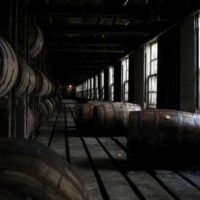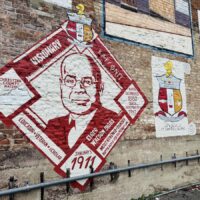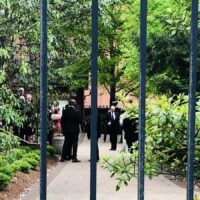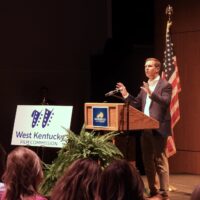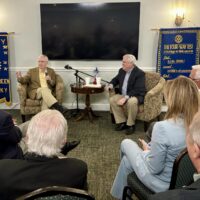“To have been there — at that moment when they first discovered the art of picture taking, when they first felt the magic in black boxes. When they first agreed, no not in words but in the still, erect way they held their bodies, that it was acceptable for the photographer to capture their likeness, their dress, their most intimate look.”
She is the woman in the blue dress with a gold brooch. She wears tiny earrings and a string of pearls and has her hair pulled back from her face. She doesn’t smile — perhaps encouraged not to so she can hold her pose for the long exposure — but she stares straight forward with her bright, hazel eyes. The photographer releases the shutter …
CLICK!
A sistering moment is captured.
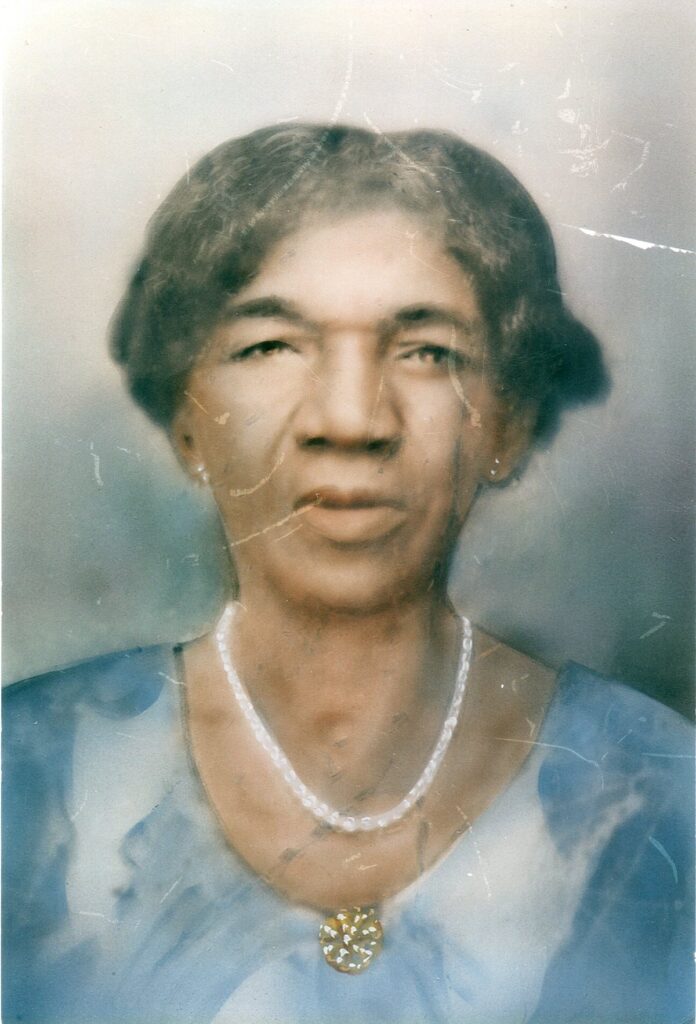
March is Women’s History Month, so it seems fitting to introduce a powerful Christian County woman. This image comes from a color-tinted portrait. It was first shown to me during an oral history interview that I conducted years ago, and it stuck with me. It’s her eyes. They have so much depth, so much power, so much intrigue. I knew she had a story to tell, and I love a good story. After learning more about her from newspapers and historical research, I wouldn’t classify her story as “good,” but I will say it as one we all need to know.
So, who was she?
She was a daughter, a sister, a wife, a mother, a widow, a grandmother and a great-grandmother. She was an ancestor, an aunt, a friend, a caregiver, a breadwinner, and a survivor.
Born in Christian County in the 1870s, she first appears with her parents and five siblings on the historic record in the 1880 Census in the Union Schoolhouse district. This district fell along the western part of the county just south of Hopkinsville and included Gracey, Newstead, and Pee Dee. Her father is listed as “mulatto,” or biracial, and was a farmer. Undoubtedly, both of her parents were formerly enslaved — and likely on the farm of a nearby white family of the same last name. The 1860 Slave Schedule for Christian County lists 17 people owned by Evan B. Blair, a farmer near Herndon. No names of the enslaved persons are given; only their ages. Both a boy, age 13, and a girl, age 6, are on this list. These ages match those of the parents of the woman in the portrait, and while I can’t be certain, there is a strong likelihood that these are her mother and father.
Her father married again in 1884, when she was around 11 years old. I could not find a record of divorce or death for the woman’s mother.
The father moved to town by 1900 and had at least two more children with his second wife. He died suddenly of heart trouble in 1904. His daughter would have been in her early 30s at the time of his death.
The woman in our photograph married on Christmas Day in 1889 when she was a teenager. Her husband Gilbert was at least 10 years older than she and had been previously married and divorced. By 1900, they had eight children. By 1910, they had twelve. The family’s records are a bit confusing. I can identify eleven of the children, six girls and five boys, by name: Lizzie, Maggie, Cornelia or Nealy, Sarah, Sink (short, I think, for Sinclair), W.B., Gilbert, Jr., Hattie, Peter Postell, Benjamin, and Pauline.
Gilbert was likely born in McCracken County and made his way to Christian through Todd. By the time of their marriage, he owned a farm in Casky between Hopkinsville and Pembroke. But Gilbert would meet a tragic end. On June 24, 1913, he was shot and killed by Will Thomas. Newspaper reports disagreed over the details that led to the fatal duel. The Hopkinsville Kentuckian reported on June 26 that the disagreement was about a $10 loan, while the Kentucky New Era reported the following day that the men had been “at outs for several days over other troubles” that boiled over about who got to use a mule that day. No matter the reason, both men fired shots, and Gilbert died as a result.
All accounts describe Gilbert as one of the most prominent African Americans in his district. He was a relatively wealthy farmer and politician, and the Hopkinsville Kentuckianreported that “his funeral yesterday depopulated the farms of the Casky neighborhood on one of the busiest days of the farming season.” He was the first man buried in Cave Springs Cemetery.
Will Thomas was found guilty of manslaughter and sentenced to two to 21 years in the penitentiary in Eddyville. He died a free man in Christian County in 1920 at Casky.
But with the death of her husband, our subject was left a widow with at least eight children still at home. At the time, her family rented the farm on which they lived. While there is no way for me to know what all this woman went through in the years following her husband’s death, I was able to determine that she and her family had moved to town by 1916. She and seven of her children lived on East Third Street, and she worked as a laundress.
The 1922 Hopkinsville City Directory, the next one available after 1916, places her at 1202 Broad St., a home she would occupy for the rest of her life. At different times, she is listed as a cook, a domestic, and as a worker in a tobacco factory. In any given year, there are varying numbers of children living in her home. It must have been a refuge for the family.
Despite my best research efforts and an obsessive drive to figure it out, I have not been able to find the date of our main subject’s passing. She is last listed in the city directory in 1951, and then she disappears from the historic record. At least, from the records available to me. I assume she is buried in Cave Springs with her husband Gilbert, but there is no headstone to prove it.
Her children each have their own stories to explore. I’ll share the basics that I found:
- The oldest, Lizzie, married twice and had three sons. She lived in Hopkinsville presumably her entire life and passed away in 1981 at age 93.
- Maggie is somewhat mysterious. She lived with her mother on and off. She died in 1944 of “sudden heart failure,” according to her death certificate.
- Cornelia, or Nealy, was listed as Cornelia Long and is listed at her mother’s former address on Broad Street at the time of her death in 1975. No children or husband were listed in her obituary as survivors.
- Sarah married Gus Oldham and had 11 children. She lived next door to her mother on Broad Street. She passed away in 1983.
- Sink was somewhat hard to track. He is listed between Pembroke and Hopkinsville for a number of years and passed away in Indianapolis in 1970.
- William B., or W.B., served in World War I and is listed in the 1930 Census in Chicago Heights with two of his brothers. It seems he may have moved back this way. He passed in 1966 and is buried at Cave Springs Cemetery.
- Gilbert Jr. moved to Indianapolis, married, and appears to have had four children. In 1975, he was listed as living in Louisville. I was unable to find the date or location of his death.
- Hattie married and at some point moved to Chicago Heights, Illinois. At the time of her death in 1974, her survivors included two sons, two daughters, four sisters, three brothers, 23 grandchildren, and 20 great-grandchildren.
- Peter Postell, assuredly named for the local wealthy African American businessman, moved to Chicago Heights where he passed away in 1995.
- Ben, like his brother Pete, appears to have moved and stayed in the Chicago area.
- Pauline, the youngest, was the first to pass away. She died of typhoid fever in 1919 at age 11. She is buried with her father.
The woman with the piercing eyes in our photograph weathered many years and many personal tragedies. But this picture and her story tell me more than that. She must have been a woman of great strength and fortitude. I’ll bet she had strong opinions and a powerful voice, and I’d put money on her being a darn good cook who could always feed multitudes. And in spite of it all, I’d guess she knew a lot — if not all — about love.
So, who was she?
She was the daughter of Stephen and Drew Blair, the wife of Gilbert Hooks, the mother of 12 children including Sarah Oldham, the grandmother of many including Rosa Bell Watkins, and the great-grandmother of many more including Gloria Jean Watkins, better known by a pen name honoring and inspired by her strong, female ancestor.
She was Bell Hooks.
The quotation at the top of the column is from Chapter 16, page 46, of “Bone Black: Memories of Girlhood” by bell hooks.
Alissa Keller is the executive director of the Museums of Historic Hopkinsville-Christian County. She’s a graduate of Centre College with degrees in history and English and of Clemson University/College of Charleston with a master’s degree in historic preservation. She serves on the Kentucky Historical Society and the Kentucky Museum and Heritage Alliance boards.
